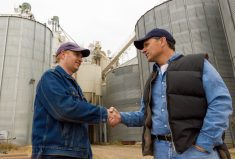There are multiple moving parts to any busy farm, and there have to be just as many to a sound HR plan too. You can pretty quickly run out of fingers if you try to count them. There’s recruitment, retention, training, evaluation … the list goes on and on.
But that doesn’t mean HR has to be an impossibly complex headache. In fact, if you keep your focus on retaining workers, managing cost, and driving your business growth, the pieces can all begin to fit together.
It will also help you become the employer of choice in the community, says Jennifer Wright, acting executive director for the Canadian Agricultural Human Resource Council (CAHRC).
Read Also

What to consider when setting up farm-related business ventures
Things to consider before launching a farm-adjacent side business.
A strategy to retain workers
“Investment in retention leads to more productive and efficient staff and to employees who are champions of their work and communicate positively through their networks about your farm being a great place to work,” Wright says. “That’s going to help you attract good talent and potential new hires.”
Kristine Ranger, an agricultural HR consultant from Michigan who helps farmers and farm businesses develop and implement HR systems, agrees, saying the key to keeping employees is to have an HR system in place that exemplifies team building and communication from top to bottom.
“Teamwork isn’t just the responsibility of the employees, it’s the responsibility of the employer as well,” she says. “The upper-level management team has to understand how to perform as a team and model appropriate behaviours.”
Only then can they be successful communicators and engage other family members, employees and the whole farm team, which is arguably the most vital component for retaining good people.
“You can’t motivate people, they have to be self-motivated,” Ranger says.
“You can reward them but money is a satisfier, not a motivator. If you give them a raise it will satisfy them for a little while, and then something happens and they’ll either ask for more money or they’ll leave,” she says. “A motivator has to be intrinsic behaviour. People want to be known, recognized and valued.”
Employees want to own the process for how they improve the operation or their job, adds Ranger, who has suggested various ways to achieve this on farms where she has worked.
“One of the things I have clients do is use graphs and charts. For instance, on a dairy farm someone can chart somatic cell counts so people have a visual job aid and anybody can see the numbers, especially if there’s a spike. Only then they can take responsibility for it. Otherwise, the only person who sees it is the person who reads the report when it comes in.”
Ranger also believes that bonuses tied to productivity can be counter productive, especially if they reward some at the expense of others.”
“Employees want to be known and recognized, and understand how their job contributes to the whole,” Ranger says. “That empowers them and builds loyalty.”
Become an employer of choice
Wright offers these key themes for creating a work environment that makes people want to stay:
Training and development
“When your employer is investing in training, you feel you are valued,” Wright says. “It keeps you engaged because you are going to learn new things.”
There are many types of training such as orientation or on-boarding, which helps set the right tone for employees as they join the organization. Then there is on-the-job training, job shadowing and apprenticeship. External training includes webinars, conferences, short courses, or more formal professional designations, post-secondary certificates, diplomas and degrees.
Training can be job-specific or required such as WHMIS, biosecurity or health and safety. It can also be more skill-specific depending on the role. Plus, there is personal development training that helps support the employee’s own mental health and well-being, perhaps something like financial management skills that they can use in their day-to-day life outside of work.
Whatever kind of training is appropriate for the farm business to offer, training should be done in an organized, planned way, Wright says.
“Make sure you take time to prepare so you know what training is needed, how you will approach it and what the content is going to be,” she says. “Make sure the employee is aware that you are going to be training them and this is part of their development. Take time to record the training that has been done and follow up to assess if it was effective.
The value of orientation and on-boarding
“The first three days are where the employees are the most impressionable,” says Ranger. “They are the most important three days for any employee … it’s critical that they get a proper orientation.”
Orientation should give new employees the basic tools they need to operate within the organization. Make introductions. Who is the best person to ask when there are questions? And make sure they know who does what.
Another thing to keep in mind is that even if they have worked in a similar operation, don’t assume anything about their knowledge. Go through everything, especially health and safety procedures, and explain how things are done in your specific operation.
CAHRC’s online Agri-Skills resources offer commodity-specific production training information, sample job descriptions, and occupational standards that can be used to develop and measure training provided. As part of its online HR Toolkit, it also offers downloadable, customizable templates to deliver and track training.
Effective HR policies
Human resource policies communicate the values and expectations of your farm business. They can act as an employee handbook and should include things like standards of acceptable behaviour.
“It gives employees a good indication that you operate your farm as a business,” Wright says.
Written HR policies also make it easier for employers to comply with regulations and employment standards that help reduce liability and risk but also ensure the farm operates in a way that meets legislation. These things always contribute to retention of staff as well.
Creating a positive work environment
A healthy, positive work environment can have a huge impact on the physical and mental health of everyone on the farm.
“It saves money because when employees are happy,” says Wright. “There are fewer accidents and errors.”
Trying to accommodate work-life balance isn’t always easy in a busy farm environment, especially during peak times, but it is essential that you support good physical and mental health.
Otherwise, you can expect higher absenteeism, turnover and worker stress.
Leaves of absence and vacation
Pushing employees or yourself to work all the time without taking time off will have a negative impact on the business. There are also legal obligations around leave and vacation time, but it’s wise to consider them as minimums.
“If you go beyond legal obligations and look at where you can provide paid leave, or support workers volunteering in the community, or support education or bereavement leave, self-funded sabbaticals, top-up programs for maternity or parental leave, or continued benefits for a leave of absence, these things help your employees feel valued and also help with retention,” Wright says.
Flexible benefits
There are many ways to provide benefits to workers besides formal dental, drug and optical plans commonly offered by larger businesses.
These can range from assistance with child care, to extended bereavement or education leave, so find out what the employees who work on your farm really value.
“Talking to your employees and finding out what is important to them will help you think about what you can offer that will benefit them,” Wright says.
A wellness program is a good example of a benefit that can contribute to a happy, healthy work environment and doesn’t need to be complicated or costly. It can include opportunities for stress management or health programming as well as some simple activities like a spirit barbecue or picnic.
Creating an inclusive workplace, where everyone feels comfortable and welcomed is increasingly important as workers come from diverse backgrounds and cultures.
How to support good mental health
Without a positive work environment, workers and employers can experience anxiety, depression, emotional exhaustion and burnout.
“Farmers are among the most vulnerable when it comes to mental health issues and certainly dealing with COVID has made mental health more important than it has ever has been for workers and for farm owners as well,” Wright says. “Make sure your environment will support positive mental health and has supports for people who need to address any mental health issues that may come up.”
Open communication and talking about mental health in the workplace is a good way to provide support and openness so employees know what to do if they are having challenges with their mental health. This should include discussions about how to recognize symptoms that someone is struggling with their mental health.
Making sure that you have created an environment where workers feel comfortable to be able to come and discuss personal issues if they arise will go a long way to preventing unnecessary stress on employees and the business.
Be flexible
As people go through life it is inevitable their circumstances will change. Being able to accommodate health issues that may pop up, or changing home situations could mean the difference between retaining or losing a valued employee. Options might include job restructuring, adjusting work schedules, flexible leave, specialized equipment, modified work sites or adjusting training or supervision.
“Conflict between work and life demands can have an impact upon your own, and workers’ mental health and having conversations, being flexible and offering supports takes one less stress away from them because they know as they manage their stress or mental health challenges come up, their employer is there for them as well,” Wright says.
Wright suggests creating a list of places people can go to for support when they are having medical or mental health emergencies, such as listings of emergency services with phone numbers, crisis lines, addictions counselling services, etc. Employers could also look at providing mental health first aid training available through the Mental Health Commission of Canada, and can also access great resources at CAHRC and Do More Ag Foundation.
Address poor working conditions
Farm owners need to provide safe and comfortable physical work environments, and address any noise, air quality or physical hazards, and assign reasonable workloads and goals.
“Provide reasonable, not over-demanding tasks, give variety tasks to reduce repetition, and let workers make their own decisions sometimes,” Wright says. “Allow them to make their own decisions when possible, and have as much control over their tasks and performance as you can.”
This can obviously be challenging during busy times when jobs just need to get done, but doing what you can to balance the workload and pressure is beneficial to everyone especially during the more hectic seasons. That begins with making sure everyone understands their role and responsibilities, which provides the stability and structure to help them meet expectations. “It goes back to orientation, training and making sure employees have the right information and skills to do the work they are being asked to do,” Wright says.
Employees also need support in unusual or emergency situations, and should know where to look for information and turn to for help.
“Emergency information and procedures can be provided in your employee handbook but it’s a good idea to have it posted around — maybe in the lunch room or other work areas,” Wright says.
Get better at communication
Positive, open communication improves team building, growth, innovation, productivity, efficiency, employee loyalty and engagement, and skill development.
“All those things are going to happen if your employees feel like they can talk to each other, they can talk to you, they can bring new ideas forward, and that they can contribute to decision making when that’s possible,” Wright says. “We can all learn from each other, and creating an environment where employees feel they can contribute is going to go reduce turnover, conflict, errors, accidents and problems.”
Ways to ensure good communications don’t have to cost money, rather it’s about how people approach the workplace and their relationships with each other. “Practice authentic communication,” Wright says, “Say what you mean and follow through with what you say.”
Create a communications-friendly culture by keeping workplace communications constant.
“Workers can feel a lot of uncertainty if they don’t know what is going to happen next, so try to keep them in the loop, maybe with a weekly team meeting or a wrap-up at the end of the week,” Wright says. “Don’t put those things on hold because you are too busy.”
Employees should always know that they are being heard and that their feedback is valued, so watch the body language and be approachable and attentive. “Standing with arms crossed during a conversation could send the wrong message to a worker, who might feel you are standoffish or not paying attention. Communication is not just what we say but non-verbal through facial expressions, body language and even our tone as well,” Wright says.
Good HR management starts and ends with thinking about what it takes to make sure employees want to keep working on your farm and it comes down to being kind.
Says Wright: “If you are open, sympathetic and willing to listen and create an environment where people feel welcomed and comfortable, you are not only going to keep the workers that you have, they are going to be happier and tell people how great it is to work for you.”
















